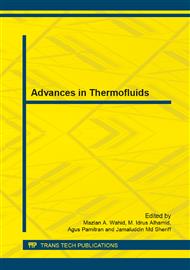p.161
p.169
p.176
p.185
p.192
p.201
p.206
p.213
p.217
The Influence of Various Inlet Geometries on Mixed Convection Flow of Ethylene Glycol in a Backward Facing Step
Abstract:
Numerical simulations of two dimensional laminar mixed convection flow over backward facing step with different inlet geometries in a duct is investigated by using finite volume method. The wall down downstream of the step is kept at a temperature of 330K and constant heat flux of 500W/m2, while the other walls that form the other side of the duct are thermally insulated. Ethylene glycol is used as working fluid and three types of barrier which are triangular, parallelogram and semicircle are carried out to compare with a simple entrance of backward facing step. The Reynolds number was in the range of 50Re200 and fluid temperature is 300K at the inlet of the channel. Parallelogram inlet has the highest average velocity in all sections and highest average Nusselt number over downstream. Also triangular inlet has the highest shear stress all over the downstream of the duct and cause to make a highest skin friction coefficient.
Info:
Periodical:
Pages:
192-198
Citation:
Online since:
August 2013
Keywords:
Price:
Сopyright:
© 2013 Trans Tech Publications Ltd. All Rights Reserved
Share:
Citation:


